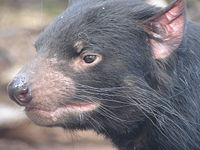Devils and Roadkill
From Santa Fe Institute Events Wiki
| CSSS Santa Fe 2010 |
Next Meeting: We'll meet in a couple of days over a meal to discuss progress, but feel free to discuss a time if need arises!
Impact of prey predictability on contact network dynamics of individual foragers
We are interested in using cellular automata/agent based modelling approaches to investigate how a predictable increase of prey density (from roadkill) impacts the contact network dynamics of a group of individual foragers (Tasmanian Devils). We are interested in how the frequency at which devils interact (and with whom) scales with the ratio of prey density on roads to background levels. (Gavin Fay)
The context for this foraging work is that determining how supplementing the prey base (from roadkill) might impact the transmission dynamics of Devil Facial Tumour Disease (DFTD) among the devil population. Additional interests of ours are therefore related to modelling dynamics of infection within the network, which could also be connected with population dynamics models, and changes in life history traits (infected populations are now semelparous, with a large drop in age of sexual maturity).
Working group / interest
- Gavin Fay
- Megan Olsen
- Joseph Gran
- Vanessa Weinberger
- Oana Carja
- John Paul Gonzales
- Julie Granka
- Anne Johnson
- Zhiyuan Song
Background
Tasmanian Devils, the largest marsupial carnivore, are currently experiencing a dramatic reduction in population due to DFTD, a rather nasty infectious cancer which has become prevalent through much of the state. DFTD infection relies on transmission of infected cells from contact, most likely due to biting, which these critters do a lot of during mating and around prey carcasses. A hot conservation topic right now is forestry plans to build roads opening up a wilderness area in the north of the state to ecotourism opportunities. The devil population in this area has until now remained disease free. There are concerns that the road will increase the likelihood that DFTD will spread to the diseasse-free population: Devils are scavengers and frequently feed on roadkill, the creation of a road may then provide an opportunity for increased frequency of contact between infected and disease-free devils. It might be interesting to investigate how introducing a fixed-location source of additional prey items (ie a road) to a devil population would change the contact network for Devils, and then also to what extent the increased contact frequency would have to be to facilitate transmission of DFTD from an infected devil population to a disease-free one.
Methods/Approach/Ideas
ABM approach - Model Devils as random walkers on a grid, that move diffusively toward prey locations. Use Devil densities from mark recapture estimates. Prey map is stochastic, with intensity of spatial process given by a base mortality rate. Parts of grid that are road have higher mortality rate (tunable ratio relative to base mortality rate). Keep track of who meets who, and how often. Build network, with weights of links driven by frequency of interaction. Analyse network structure when conducting simulations with/without a road. Other scenarios include, values for ratio of prey densities, how rapidly devils move toward prey, etc. (Gavin Fay)
Start off with random grid. Possible extensions could include importing GIS of parts of Tasmania for road locations. Approach above assumes that interaction occurs given same location - if we are going further with disease transmission etc, then we could have a probability of fighting/injury given an interaction.
Basic Model
From meeting on 06/14/10 (Megan Olsen):
The Basic model will NOT have disease, mating, natural death, etc. It will only have what is explicitly listed in this section.
The world:
- Bounded grid (not a torus)
- Overlap (multiple agents on a single grid point) is allowed
- Essentially a Cellular Automata (decision rules are based on stochasticity and states in neighborhood)
Agents/Predators (Devils):
- Moore neighborhood of interaction (8 neighbors, this includes cardinal points and diagonals)
- Random walk on grid
- If smell of prey is within neighborhood, will follow it with some (high) probability
- Pr(Fight|Overlap) will be considered, but set to 1 (i.e. they will always fight if on same gridpoint)
- Will follow strongest gradient of smell when there is a choice; if multiple directions are equivalent will choose randomly
Prey (Roadkill):
- Have a defined "lifetime," the strength of their smell will decay with their lifetime until they disappear from end of lifetime or from being eaten
- Smell diffuses within some radius; diffuses evenly in all directions
Start State:
- Multiple populations of devils on grid
- Random distribution of prey with higher likelihood where we want there to be a "road"
Timestep Includes:
- Devils act (move, eat, fight)
- Diffusion of smell
- Decay in prey lifetime
Necessary Parameters whose ranges should be determined through literature:
- Size of home range for devils
- Densities of prey and predator
- Distance smell can diffuse such that devil can still smell it
- How quickly prey will decay if not eaten
Some recent (possibly relevant) papers on DFTD
(Warning: some may find images contained within these papers disturbing)
- Hamede et al. 2009. Contact networks in a wild Tasmanian devil (Sarcophilus harrisii) population: using social network analysis to reveal seasonal variability in social behaviour and its implications for transmission of devil facial tumour disease
- Jones et al. 2008. Life-history change in disease-ravaged Tasmanian devil populations
- McCallum et al. 2009. Transmission dynamics of Tasmanian devil facial tumor disease may lead to disease-induced extinction
- Hamede et al 2008. Seasonal, demographic and density-related patterns of contact between Tasmanian devils (Sarcophilus harrisii): Implications for transmission of devil facial tumour disease
Other Resources
Risk assessment of the Tarkine Drive (a little enlightening)
Road Kill Tasmania, Maps of Roadkill Hotspots], info from the Hobday paper.

